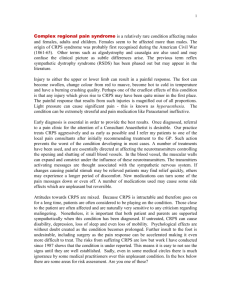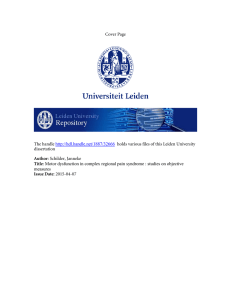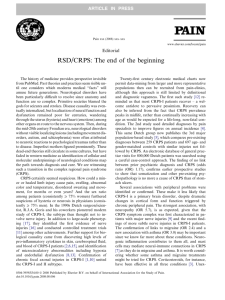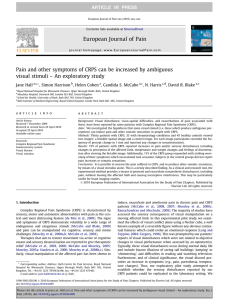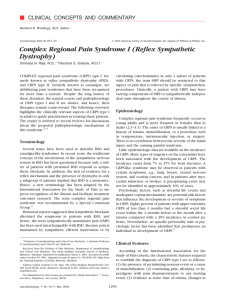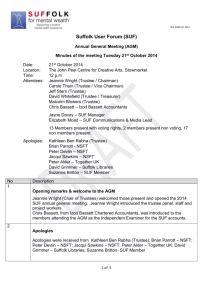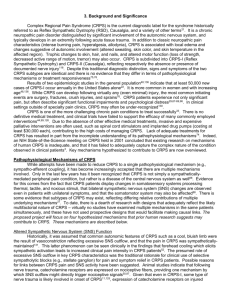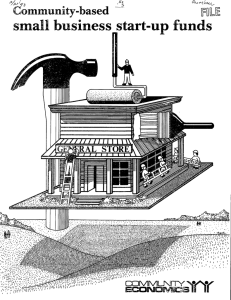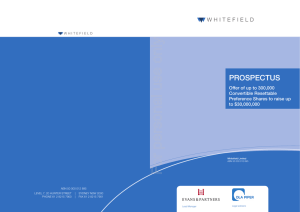CHEM 1210 Exam #3 Dr. Kroner Practice 3
advertisement
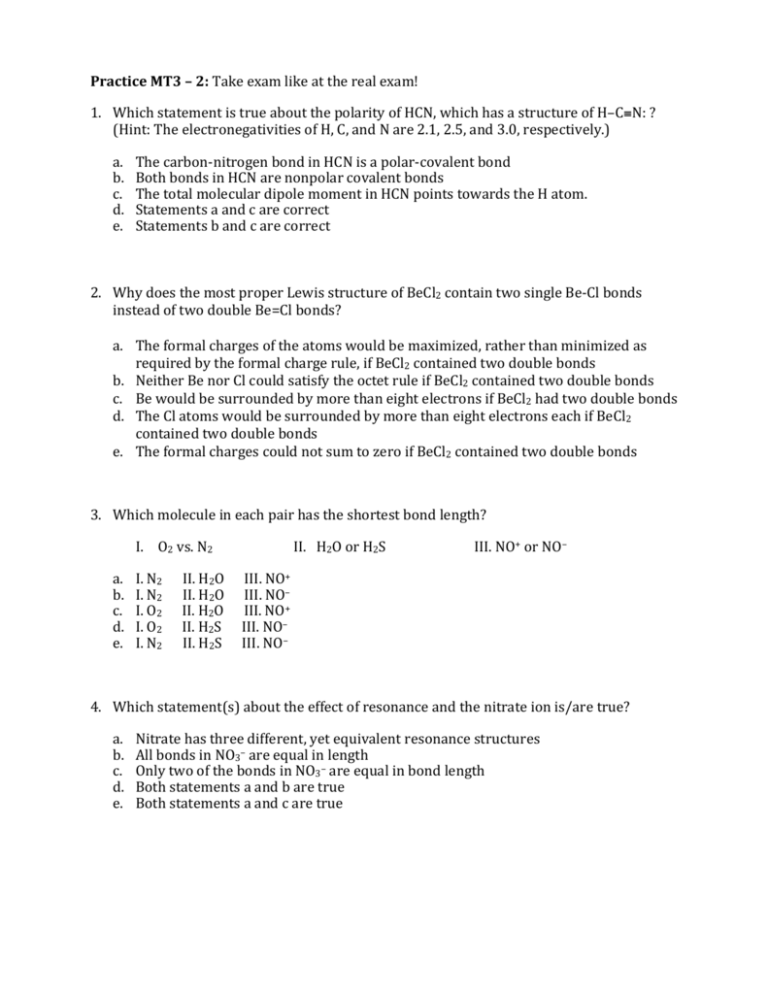
!"#$%&$'()*+(,(-.("#$%!%&#'!()$%!#*!*+%!,%#(!%&#'-! ! ./ 0+)1+!2*#*%'%3*!)2!*,4%!#564*!*+%!76(#,)*8!69!:;<=!>+)1+!+#2!#!2*,41*4,%!69!:?;!<@!A! B:)3*@!"+%!%(%1*,63%C#*)D)*)%2!69!:=!;=!#3E!<!#,%!F/.=!F/G=!#3E!H/I=!,%27%1*)D%(8/J! ! #/ "+%!1#,563K3)*,6C%3!563E!)3!:;<!)2!#!76(#,K16D#(%3*!563E! 5/ L6*+!563E2!)3!:;<!#,%!36376(#,!16D#(%3*!563E2! 1/ "+%!*6*#(!'6(%14(#,!E)76(%!'6'%3*!)3!:;<!76)3*2!*6>#,E2!*+%!:!#*6'/! E/ M*#*%'%3*2!#!#3E!1!#,%!16,,%1*! %/ M*#*%'%3*2!5!#3E!1!#,%!16,,%1*! ! ! ! F/ 0+8!E6%2!*+%!'62*!7,67%,!N%>)2!2*,41*4,%!69!L%;(F!163*#)3!*>6!2)3C(%!L%K;(!563E2! )32*%#E!69!*>6!E645(%!L%O;(!563E2A! ! #/ "+%!96,'#(!1+#,C%2!69!*+%!#*6'2!>64(E!5%!'#&)')P%E=!,#*+%,!*+#3!')3)')P%E!#2! ,%Q4),%E!58!*+%!96,'#(!1+#,C%!,4(%=!)9!L%;(F!163*#)3%E!*>6!E645(%!563E2!! 5/ <%)*+%,!L%!36,!;(!164(E!2#*)298!*+%!61*%*!,4(%!)9!L%;(F!163*#)3%E!*>6!E645(%!563E2!! 1/ L%!>64(E!5%!24,,643E%E!58!'6,%!*+#3!%)C+*!%(%1*,632!)9!L%;(F!+#E!*>6!E645(%!563E2!! E/ "+%!;(!#*6'2!>64(E!5%!24,,643E%E!58!'6,%!*+#3!%)C+*!%(%1*,632!%#1+!)9!L%;(F! 163*#)3%E!*>6!E645(%!563E2!! %/ "+%!96,'#(!1+#,C%2!164(E!36*!24'!*6!P%,6!)9!L%;(F!163*#)3%E!*>6!E645(%!563E2!! ! ! ! H/ 0+)1+!'6(%14(%!)3!%#1+!7#),!+#2!*+%!2+6,*%2*!563E!(%3C*+A! ! R/! SF!D2/!<F! ! ! ! RR/! :FS!6,!:FM! ! ! ! RRR/!<ST!6,!<S?! ! #/ R/!<F!!!!!!RR/!:FS!!!!!!RRR/!<ST! 5/ R/!<F!!!!!!RR/!:FS!!!!!!RRR/!<S?! 1/ R/!SF!!!!!!RR/!:FS!!!!!!RRR/!<ST! E/ R/!SF!!!!!!RR/!:FM!!!!!!RRR/!<S?! %/ R/!<F!!!!!!RR/!:FM!!!!!!RRR/!<S?! ! ! ! U/ 0+)1+!2*#*%'%3*B2J!#564*!*+%!%99%1*!69!,%263#31%!#3E!*+%!3)*,#*%!)63!)2V#,%!*,4%A! ! #/ <)*,#*%!+#2!*+,%%!E)99%,%3*=!8%*!%Q4)D#(%3*!,%263#31%!2*,41*4,%2! 5/ W((!563E2!)3!<SH?!#,%!%Q4#(!)3!(%3C*+! 1/ S3(8!*>6!69!*+%!563E2!)3!<SH?!#,%!%Q4#(!)3!563E!(%3C*+! E/ L6*+!2*#*%'%3*2!#!#3E!5!#,%!*,4%! %/ L6*+!2*#*%'%3*2!#!#3E!1!#,%!*,4%! ! ! ! ! ! ! ! G/!!0+)1+!N%>)2!2*,41*4,%!5%(6>!5%2*!,%7,%2%3*2!<FS/! ! #/! <OSO<! ! 5/! <O<OS! ! 1/! <!<KS! ! E/! <!SK<! ! %/! <K<!S! ! X/!!:6>!'#38!*6*#(!"!#3E!#!563E2!#,%!*+%,%!)3!<FSA! ! #/! ! 5/! 1/! ! E/! ! %/! .!"!#3E!.!#!563E! F!"!#3E!.!#!563E! .!"!#3E!F!#!563E! F!"!#3E!F!#!563E2! F!"!#3E!H!#!563E2! ! Y/!;+662%!*+%!'%'5%,!)3!%#1+!7#),!>)*+!*+%!2+6,*%2*!563E!(%3C*+/!Z&7(#)3!864,!1+6)1%/! ! #/ "+%!1#,563K6&8C%3!563E!)3!;S!6,!*+%!1#,563K6&8C%3!563E!)3!;:FS! ! ! ! ! ! ! 5/ "+%!1#,563K+8E,6C%3!563E!)3!;:U!6,!*+%!56,63K+8E,6C%3!563E!)3!L:H!! ! ! ! ! ! 1/ "+%!6&8C%3K6&8C%3!563E!)3!SF!6,!*+%!6&8C%3K6&8C%3!563E!)3!SFF?!B:)3*@!864!1#3!1632)E%,! %)*+%,!*+%),!N%>)2!2*,41*4,%2!6,!'6(%14(#,!6,5)*#(!E)#C,#'2!*6!#32>%,!*+)2!Q4%2*)63J! ! ! ! ! [/! ;632)E%,!24(94,!E)6&)E%/! #/ \,#>!#((!69!)*2!7622)5(%!N%>)2!2*,41*4,%B2J/! ! ! ! 5/ M%(%1*!#3E!%&7(#)3!*+%!'62*!7,67%,!2*#*%'%3*!#564*!*+%!563E2!)3!3)*,)*%@!B;),1(%!63%J! )/ "+%!563E2!)3!*+%!'6(%14(%!#,%!%Q4#(!)3!563E!(%3C*+! ))/ "+%!563E2!)3!*+%!'6(%14(%!E)99%,!)3!563E!(%3C*+! ! Z&7(#3#*)63@! ! ! ]/ 0+)1+!'6(%14(%!+#2!*+%!C,%#*%2*!563E!6,E%,A! ! #/ ;FFT! 5/ ;FF?! 1/ SF! E/ SFF?! %/ ^F! ! .I/ 0+)1+!,#3$)3C!69!58!6,E%,!69!)31,%#2)3C!563E!(%3C*+!)2!16,,%1*!96,!SF=!;F=!#3E!<FA! ! #/ SF!_!<F!_!;F! 5/ ;F!_!<F!_!SF! 1/ <F!_!SF!_!;F! E/ <F!_!;F!_!SF! %/ ;F!_!SF!_!<F! ! ../!0+)1+!'6(%14(%V)63!>64(E!+#2!*+%!2+6,*%2*!6&8C%3K6&8C%3!563E!(%3C*+A!! ! ! #/! SFK! ! 5/! SF! ! 1/! SFT! ! E/! SFFK! ! %/!! `6,%!)396,'#*)63!)2!3%%E%E! ! .F/!"+%!D#(%31%!6,5)*#(2!)3!5,6')3%!)3*%,#1*!>)*+!*+%!2#'%!7#**%,3!#2!9(46,)3%/!0+#*!)2!*+%! 7,67%,!D#(%31%!`S!1639)C4,#*)63!69!5,6')3%A! ! #/ "F2F!"aF2F!"F7F!bF7U!baF7U! 5/ "U2F!"aU2F!"U7F!bU7U!baU7U! 1/ "U2F!"aU2F!bU7U!"U7F!baU7U! E/ "U2F!"aU2F!"U7F!"aU7F!bU7U!baU7F! %/ <63%!69!*+%!#56D%! BZ&#'!163*)34%2!>)*+!cFHJ/!! ! 23. Use the following bond energies to calculate ÄH° for the given reaction. (H - C = 414; C - C = 347; C = C = 619; H - H = 435) H H H H | | | | H-C=C-H+H-H ! H-C-C-H | | H H A. -55 B. -102 C. -72 D. -121 E. -92 24. The bond angles in IF2+ are A. B. C. D. E. 25. exactly 90° slightly less than 90° exactly 109.5° slightly less than 109.5° exactly 120° Write resonance structures for NO2-. Based on these structures one can conclude that the bond order of the N - O bond is A. B. C. D. E. 26. . ! 1 1! 1! 1" In the following oxidation reaction the shape of the reactant is SF4 """"! SF42+ + 2 eA. B. C. D. E. tetrahedral, square pyramid tetrahedral, see-saw see-saw, tetrahedral T-shaped, square planar square planar, T-shaped and the shape of the product is . 27. What types of hybrid orbitals are involved in bonding of SO42-? A. B. C. D. E. 28. Draw the Lewis formula for NH2-. What term describes the shape of this species? A. B. C. D. E. 29. sp3 sp2 sp dsp3 d2sp3 linear bent tetrahedral square planar see-saw Which of the following is an acceptable Lewis structure for H2CNH? .. .. H C N .. H H A. .. H C N H B. H .. H C N .. H H C. .. H C N H D. H .. H C N .. H H E. 30. Consider the following molecules and select those that are polar. 1) ClF A. B. C. D. E. 31. 1 and 2 2 and 3 1 and 3 1, 2 and 3 only 3 one two three zero Which of the following has bond angles of approximately 120°? 1) ClF3 A. B. C. D. E. 33. 3) ClF5 The oxalate ion, C2O42- has a single bond between the carbon atoms and each carbon atom is bonded to two oxygen atoms. Write a resonance form conforming to the Lewis octet rule and determine the number of double bonds in this species. A. B. C. D. 32. 2) ClF3 2) BF3 3) ClO3- 4) SF4 1 and 4 2 and 3 2 only 4 only 5 only Which of the following molecules is nonlinear? A. B. C. D. E. SO2 CO2 HCN C2H2 HCl 5) GeCl4 34. What is the density (g/L) of carbon dioxide at 30.3°C and 744 mm Hg? A. B. C. D. E. 35. A gas occupies 250. mL at 700. torr and 300. K. What volume (mL) will the gas occupy at 350. torr and 450 K? A. B. C. D. E. 36. 1.85 1.73 1.61 1.42 1.28 750. 83.3 375 500. 950. Imagine two flasks of identical volume. One contains 2 grams of H2 at 200 K and the other contains 2 grams of He at 800 K. Which of the following properties are the same for the two flasks? I pressure II average KE III density IV number of molecules V average velocity A. B. C. D. E. 37. I III & IV III IV III & V Consider three one-liter flasks labeled A, B, and C filled with the gases NO, NO2, and N2O, respectively, each at STP. Which flask contains 1.0 mole of gas? A. B. C. D. E. flask A flask B flask C none all are the same 38. What volume (L) of O2 at STP is required to burn 1.3 g of acetylene at STP? 2 C2H2(g) + 5 O2(g) ! 4 CO2(g) + 2 H2O(g) A. B. C. D. E. 39. 2.1 2.8 1.8 3.2 2.5 A 1.14 g sample of impure aluminum carbide reacts with water to give 452 mL of CH4 at 20.0"C and 745 mm Hg. What is the % Al4C3? Al4C3(s) + H2O(l) #$# 3 CH4(g) + 4 Al(OH)3(s) A. B. C. D. E. 40. Which of the following statements about kinetic energy (K.E.) is true? A. B. C. D. E. 41. 74.2 80.2 77.6 82.4 72.1 All objects moving with the same velocity have the same K.E. As the velocity of a body increases, its K.E. decreases. The K.E. of a body will quadruple if its velocity doubles. The K.E. of a body is independent of its mass. None of the these are true. A mixture contains 1.20 g helium, 4.00 g neon and 6.50 g argon. What is the partial pressure (mm Hg) of argon in the mixture at STP? A. B. C. D. E. 242 345 187 425 122 42. The rms speed of an O2 molecule is 425 m/s at 0.00°C. What is the rms speed at 100.0°C? A. B. C. D. E. 43. 425 497 515 535 581 Which of the following can form intermolecular hydrogen bonds in the pure liquid? H H H H H H C C C O H 1) A. B. C. D. E. 44. H H H H H H H H C C O C H 2) H H H H C C C H 3) H OH H 1 only 2 only 3 only 1 and 2 1 and 3 Which one of the following DECREASES as the strength of the attractive intermolecular forces INCREASES? A. B. C. D. E. The heat of vaporization. The normal boiling temperature. The extent of deviations from the ideal gas law. The sublimation temperature of a solid. The vapor pressure of a liquid.

